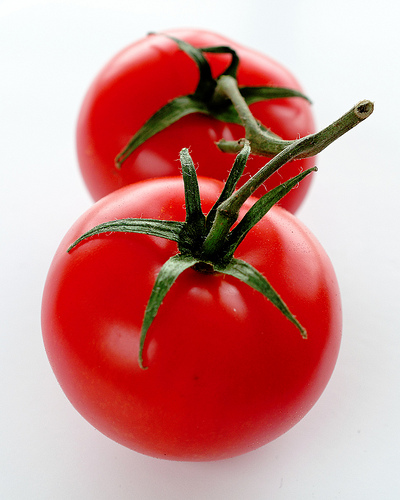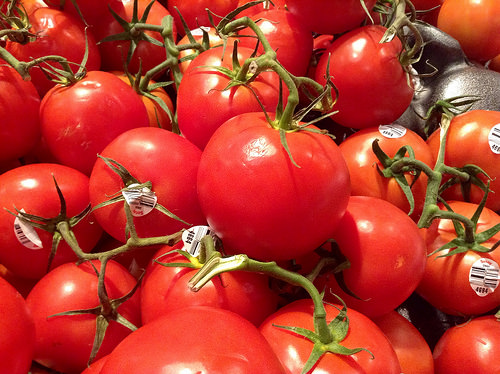Concentric Rings On Tomatoes

Gardening Question from Steve:
My first year planting tomatoes I have concentric rings on a lot of my plants what do I do?

Photo by JeepersMedia 
Answer from Pat:
I need more information before i can answer this question intelligently: Where are the concentric rings on your plants. On the leaves? Under leaves or on top of leaves? on the stems? or on the fruit? What color are the concentric rings? white, black, yellow, or brown? Have you looked under magnifier? Are they eggs? About how large are the concentric rings? If on fruit are they located on stem end or on the blossom end? Where are your tomatoes growing? (Full sun? What climate zone or location?)
If you send back this information, I can answer the question with a chance of being correct, but in the meanwhile, here are some ideas. You may find the answer to your problem here and won’t have to write back with exact description of problem, but next time please give more information:
If the concentric rings are on fruit and and are large, firm, smooth, brown spots with concentric zones, then your tomatoes have Buckey rot. (Concentric rings from Buckeye rot can occur on stem end or on blossom end of fruit.) Mulching the soil can help. Sterilize soil by soil solarization (Pages 295-296 in my book) to prevent reoccurrence next year. It is possible that Serenade® might help you protect plants and other fruit from this fungal disease.
If the concentric rings are underneath the leaves and if they are white and beginning to give off white, dusty threads, they are eggs of the larvae of giant white fly and the best defense is to cover the soil under the plant with an inch or two of dry, bagged earthworm castings. This gets rid of giant white fly in about 2 weeks. (But problems with giant white fly are less this year which makes me think the Department of Agriculture campaign to introduce beneficials to kill them is working. Cool weather has also reduced their numbers at least along the coast.)
If there is dark brown to black color surrounding the stem end of the fruit and concentric rings at the stem end your fruit has Early Blight. Spray the plant and fruit with Serenade®, start earlier as a preventative next year. Bordeaux mixture also controls Early Blight. Keep garden clean. Use crop rotation. Use soil solarization if you can before planting tomatoes in that spot again.
All the above (except giant white fly) are diseases, but there is also a condition of “Concentric Rings” that is brown or black concentric curved cracks radiating outwards from the stem end. This comes from splitting of the epidermis of the fruit caused by swings of temperature, bad weather conditions, and or uneven watering. Fix the watering if you can by watering deeply once a week or less often instead of using drip. You can’t do anything about the weather other than making sure the fruit is well protected by the foliage. Pruning off too many leaves can leave fruit exposed to weather. Sometimes that causes cracking. Mulching soil can help maintain even moisture.
Photo by DaveCrosby 


I am sorry to bother you, but I have grown tomatoes for years near Pasadena, CA. Last summer my tomatoes were decimated with spider mites. I used to soap stuff from Armstrong Gardens, but that did nothing. I just threw out a new plant. How can Iprotect my new plants this summer, or should I skip growing tomatoes this summer? Thanks for your time.
You are not a nuisance! I suggest you check Steve Goto’s advice on growing tomatoes in the same place year after year by layering things like compost, chicken manure, horse or cow manure, and especially for pest control earthworm castings on top. I have been topping my tomato bed with earthworm castings for years and find it kills diseases and pests on tomatoes even when I cannot rotate the crop.
Look up Steve Goto online. There is a Rogers Gardens video. I love Rogers Gardens and until recently spoke there to enthusiastic audiences once a year. However in this case the products might be ones that Rogers carries and you cannot get in your area. Please do your best to replicate or go to Rogers and get the stuff Steve recommends. Keep in mind that earthworm castings aren’t really used as fertilizer. They don’t contain a lot of nutrients, but the great thing is that they contain chitinase which is an enzyme that attacks and destroys the exoskeletons of insects which are made of chitin. Insects often live in the ground and come up annually and attack plants. In this case spider mites are arachnids not insects but my experience is that they are also deterred by earthworm castings.
I also suggest you spray with non-toxic horticultural soap every day or two. Additionally release beneficials. Pirate bugs are good against spider mites.